What is the effect of a vitality program?
An analysis of a vitality program - are employees becoming more vital?
At the request of a financial service provider, AnalitiQs analysed the ROI of their vitality program. Have their employees become more vital? Take a look at the case!
Vitality is a hot topic in many organisations, involving quite a lot of money. However, its benefits are not always clear-cut. Our client, a financial service provider, had the same experience. They invited AnalitiQs to map the effects of a vitality pilot program, in order to reach a well-founded decision to either scale up the program or terminate the pilot. AnalitiQs became involved in time to carry out a baseline measurement before and an effect measurement after the program, so as to answer the question: “Have the employees become more vital?”

Situation
A financial service provider seeks to promote vitality in and around the workplace and at work, so as to contribute to a healthy and more energetic lifestyle of its employees. To encourage its employees, this service provider had started a vitality pilot program, in which employees could participate on a voluntary basis.
The program was aimed at reducing the amount of inactive time sitting down, exercising more, eating healthier food, improving sleep and reducing stress. Its goals were to increase the knowledge about vitality, generate more awareness, set targets, increase readiness to change, and thus, ultimately, to improve various KPIs (including engagement and eNPS).
AnalitiQs performed an HR ROI (return on investment) analysis to measure the effects of the vitality program, so as to allow the financial services provider to make a well-grounded decision whether or not to roll out the program across the organisation.
Approach
The vitality pilot program involved 227 employees from one department within the organisation. Prior to the pilot, AnalitiQs carried out a baseline measurement to measure the initial situation. The baseline measurement consisted of a quantitative questionnaire with twenty questions about vitality topics, e.g. knowledge and behaviour, and contained various constructs to measure KPIs, such as engagement and eNPS.
The employees then started the vitality program, which included things such as self-monitoring with an activity tracker** (measuring the number of footsteps, active time during the day, Kcal consumption, distance travelled, whether the personal exercise target had been met, and the duration and quality of sleep). In addition, the participants engaged in workshops, training courses and coaching sessions on the topics of prolonged sitting, exercising more, playing sports more often, eating healthier food, improving sleep and reducing stress.
At the end of the pilot program, AnalitiQs analysed its benefits by means of an effect measurement, again using a quantitative questionnaire.
In order to exclude the possibility that differences between the baseline and effect measurements were caused by factors outside the vitality program, a control group was added (i.e. alongside the pilot group that participated in the vitality program). Obviously, this control group had not taken part in the vitality program.
To analyse the effects of the vitality program, we used significance tests to identify any differences in vitality and the other KPIs before and after the program. Naturally, we also looked for differences between the program participants (i.e. the pilot group) and the non-participants (i.e. the control group). The analysis was carried out twice for each KPI: once including only employees who participated in both the baseline measurement and the effect measurement, i.e. the area of overlap in the Venn diagrams below; and once including all respondents, even if they only participated in the baseline measurement or the effect measurement, i.e. the non-overlapping areas in the Venn diagrams below.

Outcome
The HR ROI analysis for this organisation showed that, in the short term, their vitality program had achieved two of its goals: engagement and recovery after work, marked below with a double tick; two further goals, eNPS and stress reduction, were not attained, while the remaining goals had been partially achieved (marked with a single tick).
A goal was considered ‘achieved’ if the participants showed significant improvement after the vitality program, if non-participants showed no improvement after the vitality program and if the participants had significantly better results after the program than the non-participants. A goal was considered ‘partially achieved’ if only the first or third condition had been met.
The HR ROI analysis has yielded insight in the short-term benefits of the vitality program. Since the returns did not meet the desired expectations, the organisation decided that the benefits did not justify the investment. Based on these insights, the program was discontinued.
Interested? Feel free to contact us!

